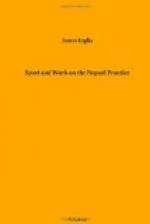[Illustration: PIG-STICKERS.]
CHAPTER XI.
The sal forests.—The jungle goddess.—The trees in the jungle. —Appearance of the forests.—Birds.—Varieties of parrots.—A ‘beat’ in the forest.—The ’shekarry.’—Mehrman Singh and his gun.—The Banturs, a jungle tribe of wood-cutters.—Their habits.—A village feast.—We beat for deer.—Habits of the spotted deer.—Waiting for the game.—Mehrman Singh gets drunk.—Our bag.—Pea-fowl and their habits.—How to shoot them.—Curious custom of the Nepaulese.—How Juggroo was tricked, and his revenge.
Tirhoot is too generally under cultivation and too thickly inhabited for much land to remain under jungle, and except the wild pig of which I have spoken, and many varieties of wild fowl, there is little game to be met with. It is, however, different in North Bhaugulpore, where there are still vast tracts of forest jungle, the haunt of the spotted deer, nilghau, leopard, wolf, and other wild animals. Along the banks of the Koosee, a rapid mountain river that rolls its flood through numerous channels to join the Ganges, there are immense tracts of uncultivated land covered with tall elephant grass, and giving cover to tigers, hog deer, pig, wild buffalo, and even an occasional rhinoceros, to say nothing of smaller game and wildfowl, which are very plentiful.
The sal forests in North Bhaugulpore generally keep to the high ridges, which are composed of a light, sandy soil, very friable, and not very fertile, except for oil and indigo seeds, which grow most luxuriantly wherever the forest land has been cleared. In the shallow valleys which lie between the ridges rice is chiefly cultivated, and gives large returns. The sal forests have been sadly thinned by unscientific and indiscriminate cutting, and very few fine trees now remain. The earth is teeming with insects, chief amongst which are the dreaded and destructive white ants. The high pointed nests of these destructive insects, formed of hardened mud, are the commonest objects one meets with in these forest solitudes.
At intervals, beneath some wide spreading peepul or bhur tree, one comes on a rude forest shrine, daubed all over with red paint, and with gaudy festoons of imitation flowers, cut from the pith of the plantain tree, hanging on every surrounding bough. These shrines are sacred to Chumpa buttee, the Hindoo Diana, protectress of herds, deer, buffaloes, huntsmen, and herdsmen. She is the recognised jungle goddess, and is held in great veneration by all the wild tribes and half-civilized denizens of the gloomy sal jungle.
The general colour of the forest is a dingy green, save when a deeper shade here and there shows where the mighty bhur uprears its towering height, or where the crimson flowers of the seemul or cotton tree, and the bronze-coloured foliage of the sunpul (a tree very like the ornamental beech in shrubberies at home) imparts a more varied colour to the generally pervading dark green of the universal sal.




